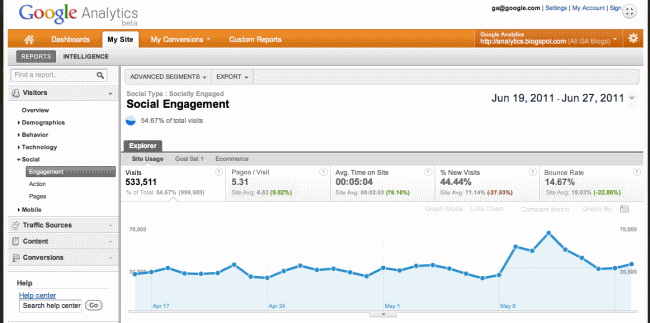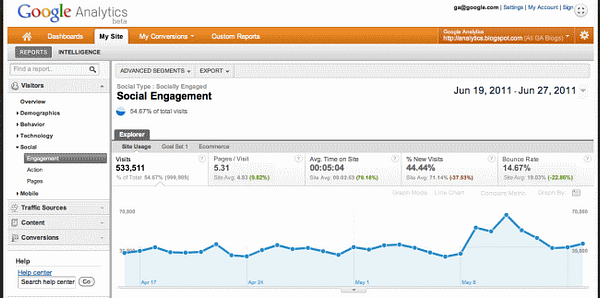What is Google Analytics
“If you can’t measure something, you can’t understand it. If you can’t understand it, you can’t control it. If you can’t control it, you can’t improve it.” ~Dr. H. James Harrington, CEO, Harrington Institute
Google Analytics is an amazing website measurement software from Google. A “web analytics software” will tell you plenty of useful information about your website.
You will get insights into what your visitors are doing on your website and how they are interacting with it.
To install Google Analytics on your website, you need to sign up for it and then to add a few lines of code on each page of your website that you want to track.
The information you get from Google about your website is organized by different criteria and called metrics.
If your website gets on average 100 visitors each day, you may say that the metric “unique daily visitors” has an average value of 100. The same principle applies to the rest of the of the metrics.
How Does Google Know How to Track Visitors?
When I visit your website, Google Analytics stores a few pieces of data about my visit. It will store my IP address, screen resolution, browser type, the time of the visit and so on.
The following are some of the most important metrics used by Google Analytics:
#1: Sessions (previously called “Visits”)
Represents the total number of times your website or a particular web page was accessed by a User during a certain period. That period can be a day, a week, or whatever you select as a time-frame. This measurement will include all visits, even multiple visits by a single user.
#2: Users (previously called “Visitors”)
The number of users or visitors that have had one unique session (or visit) on your site during a given period. If 10 different people coming from 10 different computers visit your website during a month, regardless of how many times they do it, the “visitors” metric is 10. If two people from the same computer visit the same website, Google Analytics can’t differentiate between them and it counts them as 1 visitor. Google Analytics can’t see you. It can only see the interaction between your internet browser and the website you are visiting.
#3: Pageviews
It’s the amount of pages loaded by all the visitors that visit your website. Let’s say that you visit the homepage of a website and refresh it 5 times. That counts as 5 pageviews. Let’s consider the situation when you browse the homepage, then you visit 1 article, then you come back to the home page. That counts as 3 pageviews.
#4: Unique Pageviews
The act of me visiting your website and viewing a specific page is called a “unique pageview”. If I return in 10 more minutes, Google Analytics may consider that the new visit is not unique. Google Analytics considers that I simply resume the same visit in less than 10 minutes. But if I visit your website in 10 hours, Google Analytics will consider the new visit as a new unique visit because the length of time between the visits is quite big.
#5: Pages/Visit
It’s the mathematical division between the number of pages visited and the number of visits. It’s an useful metric because it tells you how engaged your visitors are with your website. If your visitors only check the homepage it probably means that your other content doesn’t engage them enough.
#6: Bounce Rate
It’s the percentage of people who visit only the first page (A.K.A. entrance page) and then exits your website without seeing any other pages on your website. For example, someone visits your homepage and without browsing any other pages on your website, he leaves your website.
Consider the following scenario. You wrote an article on “Small Business Tips” and it got some decent traffic. As a result, 1,000 people read it on your website. Out of those 1,000 people, 700 read other articles on your website. In this situation, the bounce rate is 30%. In most cases the lower the bounce rate, the better. But, keep in mind the bounce rate would vary depending on the type of site you have.
#7: Referrers
This metrics tells you which websites send you visitors. It may be a search engine like Google or a social network like Facebook.
#8: Exit Rate
Among all the pageviews of a certain webpage, the exit rate is the percentage of situations when the visitor left your website through that particular page. Web pages with high exit rates may give some indication where your website is failing.
#9: Time on Page
It’s the average amount of time spent by your visitors on a specific page. The more time they spend on a web page, the better it is for your website. This means that they are engaged with your content.
How to get Google Analytics
Now you know the basics of Google Analytics. Go ahead, sign up for it and enjoy its power. It will help you make more sales and better understand your visitors.
More Information About Google Analytics
Try Our Easy to Use Google Analytics Guide
50 Resources for Getting the Most Out of Google Analytics
Google Analytics – Wikipedia page
Basic Q&A for Google Analytics
HOW TO: Get Started With Google Analytics
Google Analytics plugin for WordPress
Google Analytics Is Installed On More Than 10 Million Websites
Image Credit: Agustin Suarez




No Responses